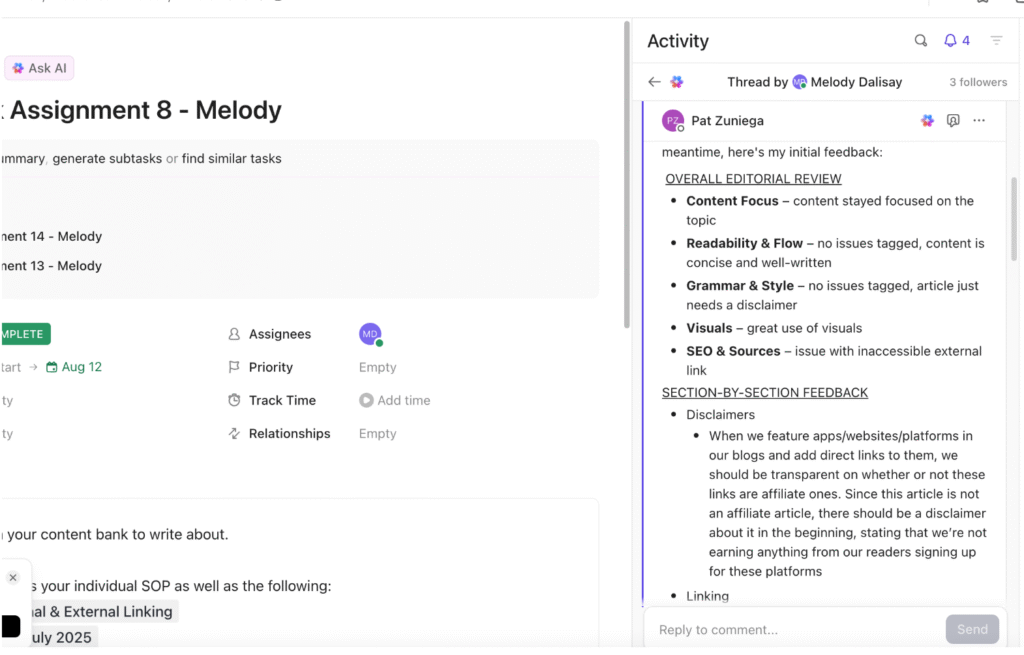Disclaimer: The external tools and resources mentioned in this blog are shared purely for research and writing purposes. We are not affiliated with, sponsored by, or compensated by these platforms in any way.
When people imagine the daily routines of writers, they often picture sudden bursts of inspiration or late-night typing marathons. But at Urban Era Marketing, my workday as a Content Writer is far more structured and surprisingly sustainable. Since adopting the one-day-ahead drafting process, I’ve learned that writing thrives on pacing, balance, and space for feedback. This approach not only boosts productivity but also eases stress and helps prevent the mental health red flags that can appear when we’re too busy. Over time, the work feels less like a race and more like a steady rhythm.
Here’s a look into my daily flow, from the quiet of morning edits to the focus of afternoon drafting, with a few trusted tools that keep everything moving efficiently. This is how I structure my day to stay productive, creative, and consistent.
Daily Routines of Writers: Morning Edits and Rituals
My mornings always begin by checking my colleagues’ drafts. I provide feedback, make edits, and offer suggestions to help refine their work. Reviewing someone else’s writing first gives me a fresh perspective and helps me reset my mindset for the day. Seeing different writing styles often sparks new ideas and reminds me that every writer approaches structure and tone differently, which is both educational and inspiring.
Sometimes I work in silence, but often I put on soft music as white noise. And I never skip my hot chocolate, it’s a small ritual that signals the start of focused work. Psychologists refer to this as cognitive offloading (the practice of reducing mental effort by relying on external information or tasks outside your own memory). By reviewing existing work first, I lighten the mental load and free up working memory for more creative and analytical tasks. This simple shift allows me to start the day with clarity, instead of juggling details in short-term memory.
Pairing that with calming rituals, like music and a warm drink, also reduces decision fatigue (the mental exhaustion that occurs after making too many decisions, leading to impaired judgment, reduced willpower, and reliance on shortcuts), helping me start the day with clarity and focus. This combination makes the morning routine both comforting and productive.
Afternoon: Finding the Writing Groove

After lunch, usually around 12:40 p.m., I enter my main writing block. This is when the real challenge begins: brainstorming. It’s the trickiest part of the process because ideas don’t always arrive on demand. Some days, the blank page feels heavier than usual, and I find myself scrapping outlines and starting fresh until the right angle finally clicks.
Once I push through that wall, drafting becomes easier. Words begin to flow, research falls into place, and scattered notes start forming a clear direction. Overcoming that initial block always feels like a small victory, a reminder that creativity often shows up after persistence, not before it.
Then comes polishing, where patience really matters. It’s not just fixing grammar; it’s shaping the blog so that every idea connects naturally and the story feels smooth. Editing can be frustrating, like untangling a knot. You solve one section only to realize another needs reworking. But there’s also satisfaction here: this is the moment when a rough draft transforms into something polished and ready to share.
The Tools I Can’t Live Without
I rely on three essential tools daily. ChatGPT helps me brainstorm fresh ideas and push past writer’s block. Unlike traditional brainstorming apps, it gives me instant prompts and alternative angles, which makes it faster to regain momentum when I’m stuck. Google is my go-to research tool, chosen over AI search engines because its depth, reach, and credibility ensure that the content I create is accurate and backed by reliable sources. Finally, Grammarly catches grammar issues and refines readability. While most text editors have spell check, Grammarly goes further by suggesting clarity, tone, and flow adjustments, making it indispensable to my workflow.
There’s research supporting why such tools are effective. Studies on distributed cognition (the idea that thinking doesn’t just happen in our minds but is shared across people, tools, and environments) show that when we use external systems like AI prompts, search engines, or grammar checkers, we free cognitive resources to focus on higher-level tasks. For me, these tools handle the technical details, letting me concentrate on creativity, structure, and storytelling rather than getting bogged down in mechanics.
Editing My Colleagues’ Drafts (and Letting Them Edit Mine)
Beyond the morning routine, the collaborative editing process is one of the most valuable parts of my day. Allowing colleagues to review my drafts and vice versa strengthens the team’s output, as feedback highlights areas that need clarification, logical gaps, or opportunities to tighten the flow, a reflection of Urban Era Marketing’s emphasis on a supportive and collaborative workplace culture.
For example, a teammate suggested reorganizing one of my articles. Their insight reshaped the structure, and the piece went on to perform 20% better than similar posts. That experience reminded me that writing isn’t just about my perspective, it’s about collective refinement.

Collaboration also builds community. Each round of edits feels less like “me versus the draft” and more like teamwork, where every writer learns, improves, and still preserves their unique voice.
Why the One-Day-Ahead Drafting Works
Working one day ahead has transformed how I manage writing. Previously, drafting and publishing on the same day created constant pressure, leaving me uncertain whether my work had enough depth. By separating drafting from editing, I gain time to refine ideas, incorporate feedback, and approach each piece without stress.
Here’s why this system makes a difference:
- Less stress – I no longer scramble to hit deadlines and can focus on clarity.
- Higher quality – Ideas have space to breathe, and edits feel more intentional.
- Better collaboration – Teammates have time to review, share feedback, and strengthen the draft.
What started as a small adjustment has become a game-changer, proving that pacing and buffer drafts lead to more creative, polished, and satisfying work.
Final Note: What I’d Tell a Beginner

If a new writer asked me about the daily routines of writers, my advice is simple: don’t obsess over the clock. Take time to research thoroughly, choose reliable sources, and approach writing with an analytical mindset. Writing isn’t just about filling a page; it’s about producing something thoughtful and trustworthy.
Most importantly, enjoy what you do. Being hired as a writer is already a milestone to celebrate. Appreciate the small rituals, leverage tools that help, and embrace the rhythm of your day. Writing daily can be challenging, but when paced thoughtfully, it becomes a sustainable and rewarding practice.
Start by setting aside just 30 minutes each morning for focused, distraction-free drafting before checking emails or messages. This small habit builds momentum and makes the rest of the writing process feel lighter.
FAQs on the Daily Routines of Writers
1. How do writers at UEM balance creativity with deadlines?
Writers use the one-day-ahead drafting process to reduce pressure and give themselves space for both creativity and thorough editing. By separating drafting from feedback and revisions, deadlines feel more manageable without compromising quality.
2. How do you stay motivated when brainstorming gets difficult?
Taking short breaks, revisiting research, or discussing ideas with colleagues often sparks inspiration. Using tools like ChatGPT for prompts or mind-mapping techniques can also help overcome creative blocks.
3. Can beginners use the same tools professional writers rely on?
Absolutely. Tools like ChatGPT, Google, and Grammarly are effective for writers at any stage. They provide support for brainstorming, research, and polishing work, allowing beginners to focus on developing their voice and storytelling skills.
4. How does collaborating with colleagues improve your writing?
Editing colleagues’ drafts and receiving feedback encourages fresh perspectives, identifies blind spots, and strengthens the overall quality of content. Collaboration helps writers refine their style while fostering a supportive team culture.
5. What habits contribute most to productivity in a writer’s daily routine?
The daily routines of writers often include a mix of structured habits, such as morning rituals, dedicated writing hours, and regular editing sessions, paired with small personal practices that spark creativity, like listening to music or journaling. These routines not only build discipline but also help writers maintain focus and consistency over time.

